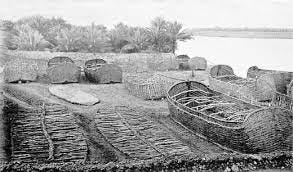Revisers of the Lost Ark
What is an ark? There's the Ark of the Covenant that Indiana Jones tried to raid, the Ark of the Law that is situated in every synagogue - and, of course, Noah's Ark. But what exactly is an ark?

Last year, I wrote a post about the challenge of building a scale model of Noah's Ark for the Biblical Museum of Natural History. (We haven't done it yet, though we did build a magnificent stylized Noah's Ark as a donor board in the entrance hall of the museum). But I think that, along with Hollywood director Darren Aronofsky, I may have made a mistake.
What shape was the Ark? Last year I wrote as follows: "Popular depictions of Noah's Ark present it as being a large boat. Boats have rounded hulls, to reduce drag as they move through the water. But the whole significance of Noah's Ark (in contrast to Gilgamesh and other such stories) is that Noah was not a sailor and the Ark was not a boat. It was not designed to move through the water, merely to float in it. It was an ark, a box, not a ship. In that respect, Darren Aronofsky's horrible 2014 film Noah with Russell Crowe was more accurate, depicting the Ark as a crate-like structure."

I wrote this because the word teivah, which also appears in the Talmud in reference to the Ark of the Law (aron hakodesh), refers to a sort of cabinet/ chest/ box, not to any kind of waterborne form of transport. But do you see the mistake that I made?
The mistake was to equate the Talmudic usage of the word with the Biblical meaning. Words change their meaning over time. For example, the word olam in Tanach means "forever," and only later was it used to mean "world" or "universe."
In Tanach, the word teivah is not used in reference to the Ark of the Covenant - that is an aron. The word appears in precisely two contexts. One is Noah's Ark, and the other is the basket that Moshe was placed in, to be floated upon the Nile. Both of them are containers that were created to float in water, and were waterproofed with pitch. As such, it seems more than likely that the word teivah refers to a vessel designed to float in the water. This would mean that even if this particular Ark was not designed to travel anywhere, it was still constructed in the same way as every waterborne vessel. (In addition, the fact that the teivah was constructed as a long, narrow structure also implies that it was modeled after a waterborne transport.) Dr. Irving Finkel, an expert in ancient Mesopotamian script, languages, and cultures at the British Museum, has written that the word tubbu appears in a 2500 year old cuneiform tablet in reference to some sort of boat - and possibly linked to the English word "tub," which also refers either to a boat, or to a container!
If the teivah was a form of waterborne vessel, this also further implies that it was not shaped like a box - all right angles - but rather like a boat, which has a rounded hull. However, this cannot be stated with certainty, since some boats still have right angles. Of especial significance is a rare photograph from 1888, of a boatyard in Iraq in which traditional boats are being constructed:

The similarity of the proportions of these boats to Noah's Ark is striking! The photographer, archeologist John Punnett Peters, described it as "A Noachian Boatyard at Hit on the Euphrates." But even though these boats are constructed with squared rather than rounded corners, they are still clearly perceived as boats rather than chests.
It therefore appears that the Biblical Ark, of both Noah and Moses, and in contrast to the Ark of the Covenant, was indeed a sort of boat. Since the function of this Ark was to house something precious rather than as a form of transport, the term later came to be used for any tub/ chest that houses something precious, like an Ark of the Law.
The good news in all this is that when we eventually do get around to building a scale model of Noah's Ark, it will look much more appealing!
If you'd like to find out how to attain fame, meaning and satisfaction by appearing on our Noah's Ark donor board, please write to advancement@BiblicalNaturalHistory.org


